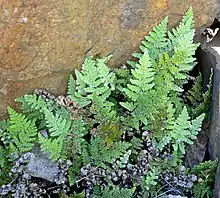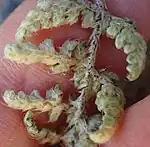| Myriopteris covillei | |
|---|---|
 | |
| Scientific classification | |
| Kingdom: | Plantae |
| Clade: | Tracheophytes |
| Division: | Polypodiophyta |
| Class: | Polypodiopsida |
| Order: | Polypodiales |
| Family: | Pteridaceae |
| Subfamily: | Cheilanthoideae |
| Genus: | Myriopteris |
| Species: | M. covillei |
| Binomial name | |
| Myriopteris covillei | |
| Synonyms | |
| |
Myriopteris covillei, formerly known as Cheilanthes covillei,[1] is a species of cheilanthoid fern known by the common name Coville's lip fern. Coville's lip fern is native to the southwestern United States and Mexico.[2]
Description
This fern has dark to medium green leaves (fronds) which may be up to 4-pinnate (made up of leaflets that subdivide up to 3 times), such that the leaflets are layered with overlapping rounded segments. The leaves as a whole have a bumpy, cobbled look when viewed from above. The edges of the leaflets are curled under (forming a false indusium) and their undersides have wide scales which are lengthened outgrowths of the epidermis. Tucked under the scales and false indusium are the sporangia, which make the spores.[2] Myriopteris covillei can be distinguished from its very similar relative Myriopteris intertexta by the scales on the underside of the leaflets. These scales are up to 3 mm wide at their base in M. covillei, giving them an elongated triangular papery appearance, whereas those of M. intertexta are 1 mm wide, appearing more like a flattened thread.[2]

Range and Habitat
Coville's lip fern is native to California, Baja California, Arizona, Oregon, and Utah.[3]
It grows in rocky crevices in the mountains and foothills. In California it is found in chaparral, yellow pine forest, pinyon-juniper woodland, and Joshua tree woodland habitats.[2]
Taxonomy
Based on plastid DNA sequence, Myriopteris covillei is part of Myriopteris clade C (covillei clade) and is most closely related to Myriopteris clevelandii and Myriopteris gracillima.[4] In addition, Myriopteris covillei is one of the parents of the fertile allotetraploid Myriopteris intertexta.[5][1][4]
Ecology and conservation
While globally apprently secure (G4), M. covillei is threatened in the northern part of its range. NatureServe considers it to be critically imperiled in Oregon, imperiled in Utah, and vulnerable in Nevada.[6]
References
- 1 2 Grusz & Windham 2013.
- 1 2 3 4 "The Jepson Herbarium".
- ↑ USDA: Cheilanthes covillei
- 1 2 Grusz et al. 2014.
- ↑ Grusz, A. L., M. D. Windham, and K. M. Pryer. 2009. Deciphering the origins of apomictic polyploids in the Cheilanthes yavapensis complex (Pteridaceae). American Journal of Botany 96: 1636–1645
- ↑ NatureServe 2024.
Works cited
- Grusz, Amanda L.; Windham, Michael D. (2013). "Toward a monophyletic Cheilanthes: The resurrection and recircumscription of Myriopteris (Pteridaceae)". PhytoKeys (32): 49–64. doi:10.3897/phytokeys.32.6733. PMC 3881352. PMID 24399906.
- Grusz, Amanda L.; Windham, Michael D.; Yatskievych, George; Huiet, Lane; Gastony, Gerald J.; Pryer, Kathleen M. (2014). "Patterns of Diversification in the Xeric-adapted Fern Genus Myriopteris (Pteridaceae)" (PDF). Systematic Botany. 39 (3): 698–714. doi:10.1600/036364414X681518. JSTOR 24546228. S2CID 16969741.
- Kirkpatrick, Ruth E.B.; Smith, Alan R.; Lemieux, Thomas; Alverson, Edward, eds. (2014). "Myriopteris covillei". Jepson eFlora, Revision 2. Jepson Flora Project. Retrieved November 12, 2022.
- "Cheilanthes covillei". NatureServe. January 5, 2024. Retrieved January 13, 2024.
External links
- Jepson Manual eFlora (TJM2) treatment of Myriopteris covillei — formerly Cheilanthes covillei.
- UC Photos gallery — Cheilanthes covillei
